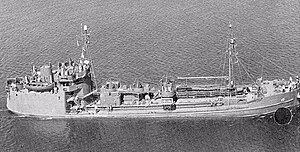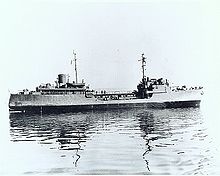T1 tanker
 USSMettawee,a 1942, T1-M-A2 tanker
| |
| History | |
|---|---|
| General characteristics |

TheT1 tankerorT1are a class ofsea worthysmalltankershipsused to transportfuel oilbefore and duringWorld War II,Korean WarandVietnam War.The T1 tanker classification is still in use today. T1 tankers are about 200 to 250 feet (61 to 76 m) in length and are able to sustain a top speed of about 12knots(22 km/h; 14 mph). Thehull designationAO is used by the US Navy to denote the ship is a T1 oil tanker and AOG that the T1 is agasolinetanker. The small size allows the T1 to enter just about anysea portor to anchor around a small island, this was very useful during thePacific War.The T1 tanker can carry about 48,000 to 280,000bbls.Some T1 tankers were used to transport goods other than oil, a few were used forblack oil-crude oil,diesel,chemicalsand rarelybulk cargolikegrain.T1 tankers are also called liquid cargo carriers. The T1 tanker has about a 6,000 to 35,000deadweight tonnage(DWT) of cargo. The small size also gives the ships short turn around time for repair, cleaning, loading and unloading. A T1 tanker carrying dirty cargo, like crude oil needs a few weeks of labor to clean before carrying clean cargo. Most T1 ships during World War II were named after majoroil fields.[1]
T1 tankers are operated by theUS Navy,War Shipping AdministrationandUnited States Maritime Commission.Some T1s were loaned toEnglandin theLend-Lease programfor World War II, after the war most were returned to the US. After World War II many of the T1 ships were sold to for civilian use. Each T1 hademergency life raftson the boat deck. The ships had cargo booms and piping to load and unload fuel. During war time the T1 are armed for protection withdeck guns.A typical ship may have one single3 "/50 dual purpose gun,two40 mm gunsand three singleOerlikon 20 mm cannon.A T1 at war time normally had a crew of 38 and up to 130. If operating as aUnited States Merchant Marineship, the crew would be a mix of civilian Merchant Marines andUnited States Navy Armed Guardsto man the guns.[2][3][4][5][6][7][8]
US classes
[edit]- T1-M-A1 tanker:Called a smallCoastal tanker,Includes theMettawee-class gasoline tanker.Diesel powered 800 hp, 10 knots max. Tonnage Deadweight: 1,600, Tonnage Full Load: 2,900, Dimensions: 221 feet long, Width 37 ft, First Navy commissioning in 1943. Built by: Barnes-Duluth SB Co. of Duluth, Minnesota. A total of eight T1-M-A1 tankers were completed for World War II.Clearwater/USSMettaweebuilt in 1943 andUSSTongue River/Pasquotankbuilt in 1943.Spindletop,Cotton Valley,Rouseville,Golden Meadowbuilt by Lancaster Ironworks, Perryville, Maryland.[9]
- Barnes-Duluth Shipbuilding,MN: 12
- Todd Galveston,TX: 8
- Lancaster Iron Works,MD: 4
- East Coast Shipyards,NJ: 2
- 2 of 34Mettawee-classgasoline tankers
- T1-M-A2 tanker:Includes theMettawee-class gasoline tanker,221 ft, diesel powered 800 hp, 10 knots max., Deadweight: 1,453 Full Load: 2,700, dimensions: 220'6 "long, Width 37 ft, Max. depth 12 ft 10 in. First Navy commissioning in 1943. Gasoline tanker, AOG, built by East Coast Shipyards Inc. of Bayonne, New Jersey. First shipUSSSeekonk.[10][11]
- T1-MT-BT1 tanker:Klickitatclass,Gasoline tankers, first in classUSSKlickitat.Enterprise dieselpowered 800 hp, 11 knots max., Deadweight: 4,000, full load: 5,970, dimensions: 325 ft 4 in long, Width 48 ft, Max. depth 19 ft, Diesel 10,465 bbls, Gasoline 871,332 gals, Crew: officers 8, enlisted 72. First Navy commissioning in 1945. Built by St. John's River SB Corp. of Jacksonville, Florida. Total T1-M-BT1 gasoline tankers-AOG completed 12. Third shipUSSNanticoke[12][13][14]
- T1-M-BT2 tanker:TonticlassandRinconclassGasoline tanker. First in classUSNSTontiandUSNSRincon.Tonticlass: Diesel electric 1018 hp, 11 knots max., Deadweight: 4933 LT, Carry 30,122 bbls, dimensions: 301.8 ft long, Width 60.92 ft, Max. depth 22.55 ft. First Navy commissioning in 1945.[15][16][17]Rinconclass: Gasoline diesel engine, 10 knots max., 6,047 long tons (6,144 t) (light) 325 ft long, width 48 ft, Max. depth 19 ft, Crew 38.
- Todd Houston Shipbuilding,TX: 14
- J.A. Jones ConstructionPanama City, FL: 6
- T1-MT-M1 tanker:Patapsco-class gasoline tankerDiesel electric system, Twin screws, 14 knots max., Capacity 680,000 gallons in 10 tanks about 2,000 tons, dimensions: 310 ft 9 in long, Width 48 ft 7 in, Max. depth 15 ft 0 in. Crew: World War II: 7 officers 120 enlisted, Vietnam: 7 officers 80 enlisted. First in classUSSPatapsco.[18][19]
- Cargill,MN: 18
- Todd Tacoma Shipyard,WA: 5
- 23 of 23Patapsco-classgasoline tanker
- T1-S-C3:Armadillo-classtanker steam powered 2,500 hp, 11 knots, single propeller, 14,245 LT displacement, 441.5 ft long, 57 ft wide, 27 ft 9 in draft, Capacity: 8,500 t. Oil 63,000 bbls, crew: 81.Z-ET1-S-C3tankers were built by California Shipbuilding in Los Angeles, California.[20]TheET1-S-C3tankers were built by Delta Shipbuilding in New Orleans, Louisiana. First in classUSSArmadillo.[21]
- T-AOG-81 tanker:TheAlatnaclasssmall T1 tanker.Alatna-class gasoline tankers. The class is named after the first shipUSNSAlatna,launched in 1956. The other ship in the class isUSNSChattahoochee.Alatnaclass has: diesel electric engines with two shafts, 3,200 hp, 13 knots max., displacements: 2,367 t (LT) 5,720 t (full load), Carry 30,000 bbls dimensions: 302 ft long, width 61 ft, max depth 23 ft. Crew of 51.[22][23][24][25][26]


Other T1 type ships
[edit]- Eddy-class coastal tanker (1953)
- Walchensee-class tanker
- SSEmpire Faun
- RFAEddyreef
- RFAEddyrock
- MVBen Bates
- Panarea-class tanker
- MTAbadan
- Type 626 tanker
- MVAqueity
- Type 631 replenishment tanker
Notable incidents
[edit]- Sulphur Bluffa T1-M-A1, renamedPunta Ciguenasank on 7 February 1960 atRio Uruguayriver inBuenos Aires.She was raised, repaired and renamedDona Isabel.[28]
- USSChehalis,a T1-MT-M1, exploded while inSamoa,caught fire and sank in 1949.
- USSEscatawpa,a T1-M-A2, ran aground and sank duringTyphoon LouiseatKyushu,Japan,on 17 September 1945. She was raised, repaired and renamedGravataiwhich sank again in 1970.[29]
- USSNanticoke,a T1-M-BT1, renamed ARAPunta Delgadawhich sank in 1985.[30]
- Nodaway,a T1-M-BT1, renamedDynafuelsank in a collision with SSFernviewin 1963 atBuzzards Bay,Massachusetts.[31][32][33]
- MSAvoca,a T1-M-BT1, renamedPetalumathenMSTranspetcaught fire and sank on 30 October 1951 after an explosion in the engine room in theGulf of St. Lawrence.
- Sebasticook,a T1-M-BT1, renamedMexia,thenKwang Lungcaught fire and sank on 5 April 1961 atKaohsiung Harbor,Taiwan.The fire-fighting party fromUSSPrichetthelp put the fire out, but she still sank, spilled a million gallons of gasoline.[34]
- USSTetonkaha,a T1-M-A2, was renamedMaumee Sun.Damaged in a collision with MVAmerican Pilotin November 1965 and then scrapped.USCGCEscanabacame to her aid after the collision.[35]
- Tarantella,a T1-M-BT2, renamed MVEsso Reguluswas wrecked after running aground onMengalum Islandin theSouth China Seanear Malaysia. on 15 January 1976, she was later scrapped in Hong Kong.[36]
- USSKlickitat,a T1-M-BT1, renamedCapitanwas wrecked in 1948, repaired and renamed MVPunta Loyola.She was sold and renamed MVAlkene,but wrecked again in 1974 off thePhilippines.[37]
See also
[edit]- T2 tankerthe next size up.
- T3 Tankerthe largest in the T class
- History of the oil tanker
- Victory ships
- Liberty ship
- Type C1 ship
- Type C2 ship
- Type C3 ship
- Type R ship
- United States Merchant Marine Academy
- United States Navy oiler
- Escambia-classreplenishment oiler
- Eddy-class coastal tanker (1953)of Royal Navy
References
[edit]- ^National Park Service, Scotts Bluff
- ^"NJ Scuba, Tanker".Archived fromthe originalon 2016-10-07.Retrieved2017-01-10.
- ^marad.dot.gov, Coastal Tankers
- ^marad.dot.gov, Coastal Tanker
- ^marad.dot.gov, Activation specifications for t1 -m-bt2 tanker
- ^Auke Visser's, T1 Tanker types
- ^navsource.org USS Klickitat (AOG-64)
- ^shipbuildinghistory, T-1 Tankers
- ^Mettawee tanker
- ^T1-M-A2 tanker
- ^T1-M-A2 tanker Todd Galveston Drydocks Inc., Galveston, Texas
- ^T1-M-BT1 tanker
- ^Klickitat Class, Walter Butler ShipBuilders, Inc., Duluth MN
- ^navsource.org, Klickitat Class Gasoline tankers
- ^navsource.org, USNS Piscataqua (T-AOG-80)
- ^T1-M-BT2 tanker
- ^T1-M-BT2, Tankers built by Todd Houston Shipbuilding Co., Houston, Texas
- ^T1-MT-M1 tanker
- ^Patapsco gasoline tanker
- ^T1-S-C3
- ^ET1-S-C3 Tankers
- ^globalsecurity.org, T-AOG-81 Alatna Small T1 Tanker Class
- ^Dictionary of American Naval Fighting Ships, Volume 3, edited by James L. Mooney, page 82
- ^NavSource Online: Service Ship Photo Archive T-AOG / T-AOT-81 Alatna
- ^history.navy.mil, Alatna Small T1 Tanker
- ^shipbuildinghistory AOG
- ^T1 list
- ^Sulphur Bluff
- ^navsource.org, EscatawpaT1-M-A2
- ^Nanticoke T1-M-BT1
- ^navsource.org, Nodaway
- ^fleetsheet,Dynafuel
- ^Dynafuelcollision with SSFernview
- ^navy.mil, Sebasticook
- ^"coltoncompany, USS Tetonkaha (AOG-41)".Archived fromthe originalon 2007-09-28.Retrieved2017-04-07.
- ^wrecksite.eu, MVEsso Regulus
- ^wrecksite.eu, MVAlkene
